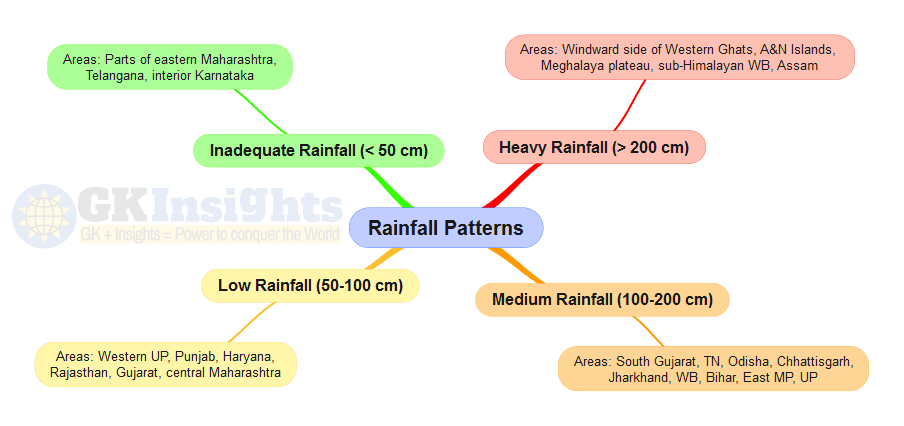
Weather and Climate
Difference between Weather & Climate

– Weather refers to the atmospheric conditions at any given place and time – temperature, humidity, rainfall, wind speed and direction, cloud cover, etc. It changes rapidly over hours and days.
– Climate refers to the long-term, 30-year average weather pattern over a large region, including the frequency and intensity of weather phenomena, seasons, temperature and rainfall characteristics.
Influences on Variations in Climate of India
Regional climatic variations across India are largely influenced by:

- Latitude – being a subcontinent with vast north to south extent, northern regions like Kashmir, Himachal are further from the equator compared to southern peninsula. This results in more extreme temperatures and seasonal variations in the north. The south has more moderate temperatures year-round
- Himalayas – act as an elevated climatic divide, protecting north India from freezing cold winds from central Asia
- Distribution of land and sea – being surrounded by the Arabian Sea, Indian Ocean and Bay of Bengal, the sea moderates coastal temperatures. Inland areas show more extremes due to absence of moderating influence
- Distance from the sea – coastal areas experience less temperature extremes compared to interior locations
- Altitude – temperatures decrease with increasing elevation. The Himalayas and high plateaus have cooler climate compared to plains and coasts
- Relief features – affect the direction of prevailing winds and distribution of rainfall.
Seasons in India
– Hot weather season (Mar-May) – Marked by high day temperatures (above 40°C) in north, west and central India. Loo blows over the Indo-Gangetic plains. Afternoon thunderstorms provide relief by bringing dust storms, gusty winds and some rainfall.
– Southwest monsoon season (Jun-Sep) – Onset around June 1 on Kerala coast, then spreads across India by mid-July. Temperatures drop substantially. Widespread rainfall occurs through formation of low pressure systems in the monsoon trough region.
– Cold weather season (Nov-Feb) – Cool, dry weather prevails over north India as temperatures drop below 21°C. Mist, fog and winter rainfall occur in some parts. South India has mild weather.
– Retreating monsoon season (Oct-Nov) – Clear skies and rise in temperatures as monsoon withdraws. October heat makes weather oppressive. Northeast monsoon brings rainfall to Tamil Nadu, Andhra coasts.
Note: India Meteorological Department (IMD) is the main agency responsible for weather forecasting
Climate Types/Regions in India
| Climatic Region | Region Covered | Characteristics |
|---|---|---|
| Tropical Wet Climate (Equatorial) | Western Ghats, Lakshadweep, Andaman and Nicobar Islands | High temperature and high humidity, heavy rainfall |
| Tropical Wet and Dry Climate (Savannah) | Interior parts of Tamil Nadu, Andhra Pradesh, Karnataka, Maharashtra, some parts of Odisha | Distinct wet and dry seasons, moderate to high temperature |
| Tropical Semi-Arid (Steppe) | Parts of Maharashtra, Karnataka, Gujarat, Rajasthan, Punjab | Low rainfall, high temperature, low humidity |
| Sub-Tropical Arid (Desert) | Western Rajasthan | Extremely low rainfall, high temperature, low humidity |
| Sub-Tropical Humid Climate | Northern plains, parts of West Bengal, Assam | High temperature in summers and cold in winters, moderate to high rainfall |
| Mountain Climate | Himalayan region | Varies with altitude; generally cold, moderate to heavy rainfall |
| Sub-Tropical Semi-Arid (Steppe) | Parts of Punjab, Haryana, Uttar Pradesh | Moderate rainfall, high temperature in summers and cold in winters |
| Composite Climate | Delhi, parts of Uttar Pradesh and Haryana | Extreme temperature variations, moderate rainfall |
| Coastal Climate | Coastal regions of Tamil Nadu, Andhra Pradesh, Odisha, West Bengal | Moderate temperature, high humidity, moderate to high rainfall |
| Island Climate | Andaman and Nicobar Islands, Lakshadweep | Moderate temperature, high humidity, high rainfall |
Indian Monsoon
– The monsoon climate arises due to the differences in heating of land and water. Being a landmass, the Indian subcontinent heats up much more during summer compared to the seas around it. This creates an area of intense low pressure over north and northwest India by early June.
– The Inter-Tropical Convergence Zone (ITCZ), characterized by rising air, shifts northwards from its equatorial position, causing the trade winds of the southern hemisphere to cross the equator between 40°E – 60°E longitudes. As these winds flow across India, they get deflected towards the southwest under the Coriolis force, becoming the southwest monsoons.
– The onset of the monsoon is aided by the withdrawal of the westerly jet stream from its position over north India allowing the establishment of the easterly jet stream along 15°N latitude. This easterly jet facilitates the burst of the monsoon over India.
– Indian Monsoon also affected by La-Nina, El-Nino phenomena
– The Arabian Sea and Bay of Bengal branches bring in moisture laden monsoon winds.The Arabian Sea branch is divided into 3 sub-branches, while the Bay of Bengal branch splits into 2.
– The monsoon rains occur over India from June to September and provide over 70% of the annual rainfall. This makes the monsoon critical for agriculture, hydro power generation and domestic water supply over most of the country.
Rainfall Patterns

– Heavy rainfall (> 200 cm) on the windward side of the Western Ghats (Konkan, Goa, Malabar coasts) and the Meghalaya plateau due to orographic influence on monsoon winds. Also in sub-Himalayan West Bengal, Assam.
– Medium rainfall (100-200 cm) in south Gujarat, Tamil Nadu, Odisha, Chhattisgarh, Jharkhand, West Bengal, Bihar, eastern MP, UP. Rainfall by monsoon depressions in the monsoon trough region.
– Low rainfall (50-100 cm) in rainshadow regions like western UP, Punjab, Haryana, Rajasthan, Gujarat, central Maharashtra. Hot semi-arid regions.
– Inadequate rainfall (< 50 cm) in interior peninsula – parts of eastern Maharashtra, Telangana, Rayalaseema, interior Karnataka. Hot arid regions.
Also Check:
– Tiger Reserves in India
– Elephant Reserves in India
– Rivers in India
Global Warming
– Increased levels of greenhouse gases like carbon dioxide, methane, nitrous oxide from human activities like burning fossil fuels, deforestation, agriculture, trap more heat and infrared radiation, increasing the average global temperatures as well as can have adverse effects on Climate of India.
– Effects of global warming include melting of glaciers and polar ice caps, rise in sea levels threatening coastal cities and islands, changes in seasons and weather patterns with more extreme weather events like heat waves, droughts and floods.
– Coastal areas in India including the densely populated deltas, island territories like Andaman, Nicobar and Lakshadweep are vulnerable to rising sea levels, coastal erosion, flooding. Ecosystems worldwide will undergo changes.
